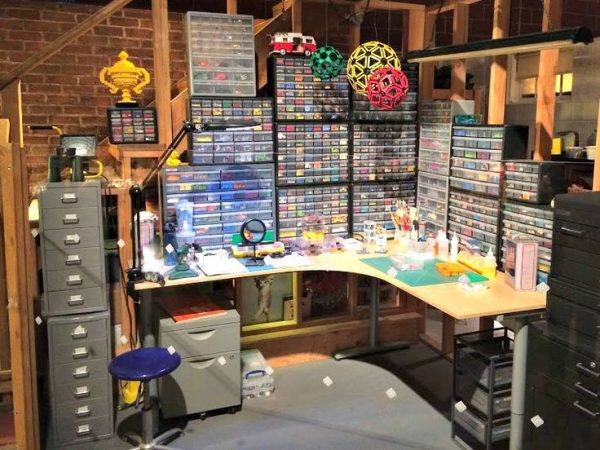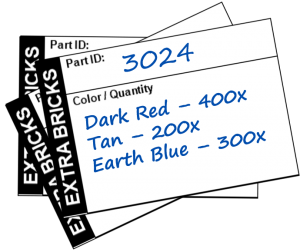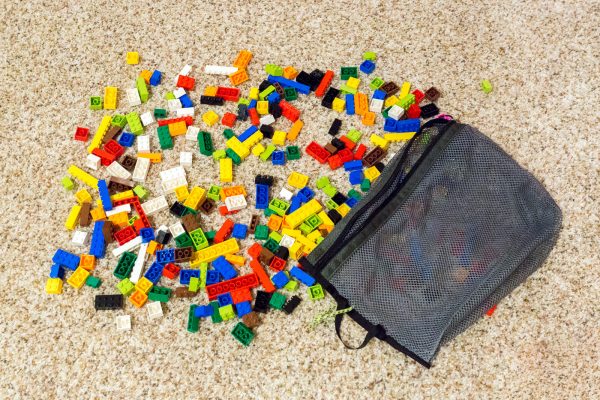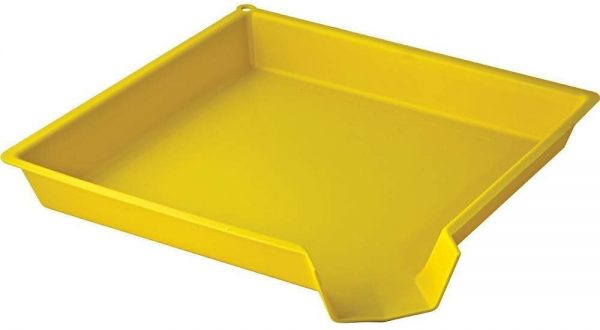Chapter 6: Additional LEGO Brick Storage Tips & Tricks
Planning for growth
As your LEGO collection gets bigger, your storage requirements will grow. Likewise, as you (or your child) become more experienced LEGO builders, you might want a more organized storage solution to make it easier to find specific parts. This is why it’s a good idea to put some thought into the growth of your collection before spending a lot of money on LEGO storage.
The easiest way to plan for growth is to allow for plenty of empty space in the storage solution that you buy now. A good rule-of-thumb is to ensure that each container in your storage solution is about half full when you organize your collection. This leaves a lot of space for new parts before you need to upgrade your storage solution.
It’s not just about leaving room in each container for more bricks… If you sort your collection by part, you will need to add additional storage as you buy new parts, especially since LEGO introduces new parts every year. (In the last 5 years, LEGO has introduced about 30 new general-purpose elements every year; that’s not including the hundreds of new printed tiles, minifigure accessories, and one-off parts created for licensed sets.)
Another good idea is to look for modular storage solutions. If you are using plastic drawer cabinets, you can start with just a few cabinets, and add additional cabinets as your collection grows. Do be wary of purchasing discontinued or off-brand storage solutions—you probably won’t be able get more when you need them. (A common complaint of LEGO builders is that they have mismatched storage solutions. This makes cabinets harder to stack, don’t look as attractive, and you can’t quickly rearrange parts without also changing their containers.)
Using Multiple Storage Systems
While there are good reasons to use the same LEGO storage solution for your entire collection, this may not be practical for several reasons.
- You might decide to re-purpose older storage solutions for seldom-used parts after upgrading to a nicer storage solution.
- You might need containers with larger compartments for your most common parts.
- You might decide to store seldom-used parts in a cheaper storage solution or a less convenient location.

Fans of The LEGO Movie will recognize Lord Business’s basement. Remember, it isn’t a toy, “it’s a highly sophisticated inter-locking brick system.”
You may also decide to keep part of your collection separate… I keep a complete set of 21050 Architecture Studio at work for lunch breaks, boring phone calls, stressed-out colleagues, or for their kids to use if they need to come into the office. (It’s in a single tackle box with removable containers, organized by category.)
Maintaining an Index
If you have a large collection, you might want to maintain an index to help you keep track of which bricks you have, and where they are stored. In the extreme case of collections sorted by element (separated by both part + color), you might store different colors in a different place.
A quick way to do this is to print the Contact Sheet based on my LEGO Brick Labels collection. You can circle all of the parts that you own, or you could write the storage location in your collection next to each part in the Contact Sheet. (It works even better if you sort your collection into the same groups used in the Contact Sheet.)
- Contact Sheet – Keep track of the parts you have, and where they are stored by printing this contact sheet and writing notes next to each part.
A few LEGO Enthusiasts maintain a digital inventory of the LEGO parts. This is possible using the BrickLink website by marking the inventory as part of your “Stockroom” (Ensuring that the parts aren’t available for others to purchase). Alternately, you can use the BrickStock app to keep track of your inventory.
Whether you use BrickLink or BrickStock, you can use the “remarks” field to indicate where the parts are stored in your collection.
Cross-referencing
If your storage solution includes an overflow storage location when the primary storage is too full, or if you keep new bricks separate from old bricks, you might want to implement a simple cross-referencing solution. This helps you remember that there are additional bricks of this type stored in a different location. (It’s pretty annoying to order more bricks, only to realize that you already had an extra bag stored somewhere else.)
I designed a simple paper card which is small enough to fit in the smaller Akro-mils drawers. I just write the approximate quantity of each color on the card, indicating that I have more of that Element (Part + Color). Extra LEGO bricks are stored in plastic bags within inexpensive Sterilite drawers.
- Extra_Bricks_Redirect.pdf – Put one of these small cards in your storage drawer or container when it is full and you have extra bricks stored somewhere else.
Cleaning LEGO
If your LEGO pieces are dirty or you purchased a large lot of used LEGO for a nice price, you may want to wash the LEGO bricks. While LEGO bricks are quite durable, you can’t expect them to look “like new” because used bricks often have small scratches along the edges, or indentations from using fingernails or teeth to separate bricks. The colors which seem to be most susceptible to fading, scratches, and visible wear are 1White and 26Black pieces.
Washing LEGO is easy!
- Put LEGO Bricks into a fine mesh bag with tight closure.
- Put bag into washing machine with other laundry and regular laundry soap. Run at a “Gentle” setting, as higher temperatures can damage your LEGO bricks.
- After washing, lay bricks out on a towel or carpet to dry.
Use extra caution if you have a top-loading washing machine — parts can be broken or scratched more easily by the agitator. Some people suggest using a dishwasher instead of the washing machine to prevent bricks from get tumbled against one another. (This works especially well for larger Duplo / Quatro bricks.)
- XL Laundry Bag – This is the top-rated laundry washing bag on Amazon, with zippered closure that works well for cleaning LEGO.
Please note that The LEGO Group does not advise washing your LEGO bricks in this way. “We recommend that you clean your LEGO® parts by hand using water no hotter than 104°F / 40°C and a soft cloth or sponge.” (Source: LEGO.com)
Funnel Tray
If your LEGO collection is sorted by category, or you sort by part and need to find the right color, it can be frustrating to find the part you need. That’s why you need a funnel tray — It allows you to dump out a whole bag or drawer of pieces, spread them out to find what you need, and quickly dump all of the pieces back into the storage container without making a mess.
Since funnel trays are inexpensive and stackable, I suggest keeping a few of them around your LEGO build area.
- Funnel Tray – A Funnel Tray makes it easier to find a specific part or color.
LEGO Ruler and Sorting Tool
With some practice, you will be able to immediately recognize the difference between a 1×3 and 1×4 brick, but it’s really hard to quickly identify the difference between a 1×12, 1×14, or 1×16 without counting the studs. That’s why I created a simple LEGO sorting tool, which you can print on thick paper, or print and laminate.
If you place a few copies of the LEGO Ruler and Sorting Tool around your build space, you will be able to quickly measure LEGO parts at any time. As you can see, it also includes a guide to help sort common Technic pieces.
- LEGO_Ruler.pdf – It’s easier to sort a lot of LEGO using a ruler.
NOTE: Be sure to print it at “100%” scaling factor. The PDF is designed to fit on both USA 8.5×11 inch and European A4 Paper.
New vs. Used bricks
Some LEGO builders keep brand new LEGO bricks separate from used bricks. This might be to help you find pristine bricks when making a model which will be photographed, or because you sometimes sell excess bricks on BrickLink.
Either way, if you wish to keep New & Used bricks separate, you will need a way to keep them separate. An easy way to do this is to keep new bricks in a small Ziploc bag alongside used bricks.






A very interesting read, thanks Tom.
In our house we adopt a mixed approach. We have what I would describe as a ‘large family collection’. Originally sorted by colour in Ikea Trofast trays, we have since moved to a blended approach. General bricks are sorted by colour still, but there’s a separate tray for ‘wheels, cars etc.’, one 1x and 2x for plates, one for ‘large plates’, and most importantly 2 sets of drawers for small parts and Technic. These are generally sorted by general type (all 1×1 plates with clip are together, regardless of orientation of clip, or colour). I’m not sure we have the perfect solution, as there is always LEGO on the floor, but there isn’t any motivation to change it! The advantages are we don’t have a HUGE amount of storage taking up space, but we can still find tiny pieces quickly.
You’ve now set my mind off wandering how many individual pieces we actually have. I wonder what your average Trofast tray holds… 🙂
Your guide is AMAZING, thank you! My son’s collection is growing rapidly and this is incredibly helpful. I was wondering if you have any storage suggestions for how to organize the various instruction manuals that come with the kits?? Thank you!
My best suggestion is a small plastic file box or for very large collections, a file cabinet. Organizing them into manila folders by theme can help organize them a bit better.
You are my hero!
I use a cotton pillow case with a low thread count. Throw the LEGO stuff inside, tie a big knot with the open end, and for extra safety, I use a zip tie or some thin synthetic string/rope tied really well (but not so much that you can’t untie it, of course). Like you mention up above, gentle cycle with regular laundry soap, then low or no heat in the dryer. Works every time.
The Index list is everything I needed in life. I recently sorted my medium lego collection. My family was really interested that I could help him with his huge collection. This Index is absoloutly impressive and will help a lot to organise everything. Thank you so much for putting this whole guide together
Anika,
I’m so happy it is a useful resource for your family! Do you plan to sort by individual pieces, or into broader categories? Both are great strategies depending on the size of your collection.
Sincerely,
—Tom
Thank you so much for putting together the labels/guide!!! I have slowly gotten the drawers, and label maker, and finally started to label and reorganize my med/large collection. Putting away LEGO is much less of a chore now, honestly I can say it’s even satisfying. I can delegate/let others help in sorting, confident that everything will get put away properly. I do have one question regarding the index labels, do you have a section suggesting how to use them? And finally, I think it could be cool if somehow you could make a stud ruler from a label, then you could stick it anywhere close. (I say that because I don’t have a regular printer, just the label maker. haha! Anyways, thank you once again! You’ve truly made cleaning up LEGO fun! (and somewhat relaxing)
Bob,
I use the “Index” labels to label the cabinets themselves, placing the index sticker near the start of each section.
As for the ruler, that’s a good idea… It’s not something I will be able to try soon, but I’ll look into it eventually 🙂
Sincerely,
—tom
I received an old collection from a friend. Most of the parts were heavily scratched from use on a concrete floor.
I had great success repairing them by stacking like parts into larger surfaces. I purchased a buffing wheel kit for my cordless drill along with polish spec’d for plastic. I then buffed the parts I had assembled.
Worked great. Everything looked brand new.
Awhile back my cat peed on our old lego bin sitting in the basement (it looked like a litter box) but then I wanted to get back into lego so we filled the container with water and bleach and let it sit in the sun for a couple of days cycled through the liquid about three times then strained it with an old bed sheet and it worked like a charm that’s the ideal way to clean lego.
I’m glad to hear that sun and a bleach water solution worked for you. I will caution other readers that sun can damage LEGO, and stickers can be damaged by water or bleach, so use caution!
I wonder why you do not recommend rebrickable.com for organizing your Lego collection. While it’s extremely useful on its own to register all sets and individual parts you own, the nice added value is that the web site will tell you what you can actually build from your collection (official sets and MOCs) and where the parts are located for a build and what pieces are missing for a particular official set or MOC – including direct support for creating a Bricklink Wanted List.
Agreed! I love that place….
I love the information you have provided. I have my work cut out for me but I’m ready to tackle it! I would love to hear how you organize your Lego instruction books. I’m still trying to figure out the best plan for that. Thanks for all you do!!
I still haven’t had a chance to write a chapter on storing LEGO Instruction Booklets, Stickers, or other flat paper memorabilia, but the short answer is a boring one – they are in a regular metal file cabinet with hanging drawers. I sort them by LEGO Theme (Star Wars, Super Heroes, Classic, Creator, Architecture, Technic etc…)
Good luck!
—Tom
A decade ago I got the idea from pinterest to pull the pages apart and sleeve protector them and binder them, tabbing out each booklet (binders by theme, tabbing in order by kit number). Now my tweenager has gone ‘high tech’ and downloaded the pdfs for all the books (folder system for theme, document by kit number and title) and uses her iphone/ipad/laptop to build. The binders are packed away in some box in the garage and I have a stack of new instruction books that need to be filed into them. I wrestle with whether or not I should just recycle them as part of the ‘paperless push’ we’ve gone to in our household; 7 3″ binders take up a LOT of space when it all fits into a harddrive.
I’m afraid that there’s no “right” answer. I personally keep instruction manuals for the sets that I actually care about in a vertical file cabinet. It’s about the most efficient solution I can think of, and I have them if I need to refer back or want to sell the set in the future.
Cheers,
—Tom
Unfortunately, the quality of the official PDF instruction is sometimes so bad, that they are far away from the printed ones. Also, for children, printed instructions is much easier to handle. I would not recommend to throw away any original instruction ever.